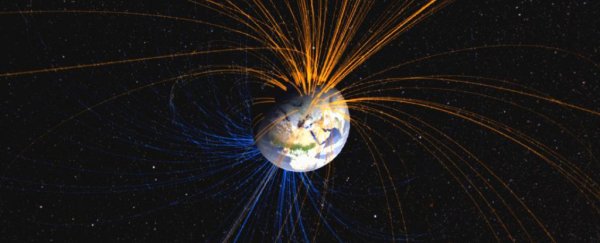Earth's magnetic field nearly collapsed some 590 million years ago, presumably putting life on the planet's surface at risk of a rise in cosmic radiation.
According to new research, the temporary weakening of the magnetic shielding might have been anything but a biological catastrophe. In fact, it may have boosted oxygen levels, creating prime conditions for early life to blossom.
"Earth's magnetic field was in a highly unusual state when macroscopic animals of the Ediacara fauna diversified and thrived," University of Rochester Earth scientist Wentao Huang and colleagues write in their new paper.
In 2019, scientists studying magnetic signatures in rocks from Canada reported that those samples indicated Earth's magnetic field weakened to its lowest known level about 565 million years old, during the Ediacaran period, when multicellular life was taking shape.
However, it was long thought that a vanishingly small magnetic field would be harmful to emerging life, because Earth's magnetic field shields life from solar winds.
Not everyone agreed with that catastrophic view, though. As far back as 1965, planetary scientist Carl Sagan argued that Earth's atmosphere and oceans could have served as a protective blanket for early lifeforms even if the planet's magnetic field waned. This was backed up by modeling studies as recent as 2019.
But any connection between a coinciding weakness in magnetic field, boom in Ediacaran life, and rise in oxygen levels has remained – as Huang and colleagues put it – "tantalizing but unclear." The Canadian results could be an outlier.
So Huang and colleagues went digging. They dug up igneous rocks from South Africa that formed billions of years ago and studied crystals in them and other 591 million-year-old rocks previously sampled from Brazil. These crystals contain tiny magnetic minerals, which preserve the intensity of the Earth's magnetic field as they form.
Just over 2 billion years ago, smack-bang in the middle of the Paleoproterozoic period, Earth's magnetic field was strong. Roughly 1.5 billion years later it dropped to its lowest ebb – about 30 times weaker than it is today, the researchers found.
Combining their results with those of the 2019 Canadian study, Huang and colleagues conclude that this lowly magnetic field (named the ultra-low time-averaged field intensity, or UL-TAFI) lasted for at least 26 million years, from 591 to 565 million years ago.
Coincidentally, this interval overlaps with a surge in atmospheric and oceanic oxygen levels around 575–565 million years ago, during the late Ediacaran, when there was also an explosion in biodiversity.
"The new data confirming and extending the UL-TAFI strengthen a potential linkage with the Ediacaran evolution of macroscopic animals," Huang and colleagues write.
But there was still the question of how an ultra-weak magnetic field could lead to increased oxygen levels. Modeling solar wind evolution, Huang and colleagues suggest the weakened magnetic field may have allowed more hydrogen ions to escape from Earth's atmosphere into space, which could have resulted in higher oxygen levels in the seas and skies, in turn supporting the diversification of Ediacaran life.
The timing at the end of Ediacaran, some 540 million years ago, is surprising – typically it's the Cambrian explosion that is regarded for its evolutionary outburst, giving rise to complex life that became the animals and insects we see today.
The Ediacaran, by contrast, is known for its slimy, squishy creatures that look like primordial sponges, slugs and sea anemones. It was a period of great evolutionary experimentation that resulted in many dead ends, and was marked by steep declines in biodiversity before life rebounded in the Cambrian.
Recent research suggests, however, that the first complex ecosystems might have actually formed in the Ediacaran, with a 2022 study describing increasingly complex community structures in fossils from the late Ediacaran.
But life needs oxygen to grow bigger and more complex. Microscopic marine animals and sponges can survive in low-oxygen oceans, but larger, mobile animals with complex body plans need more oxygen to support their metabolic demands.
"A complex animal ecosystem involving long food chains and predators requires still greater amounts of oxygen, as indicated by the exclusion of such complex ecosystems from the modern oxygen minimum zone," Huang and colleagues explain.
It seems Ediacaran life seized its moment when Earth's magnetic field faded, even if many of those creatures were destined to run into an evolutionary dead end.
The study has been published in Communications Earth & Environment.
